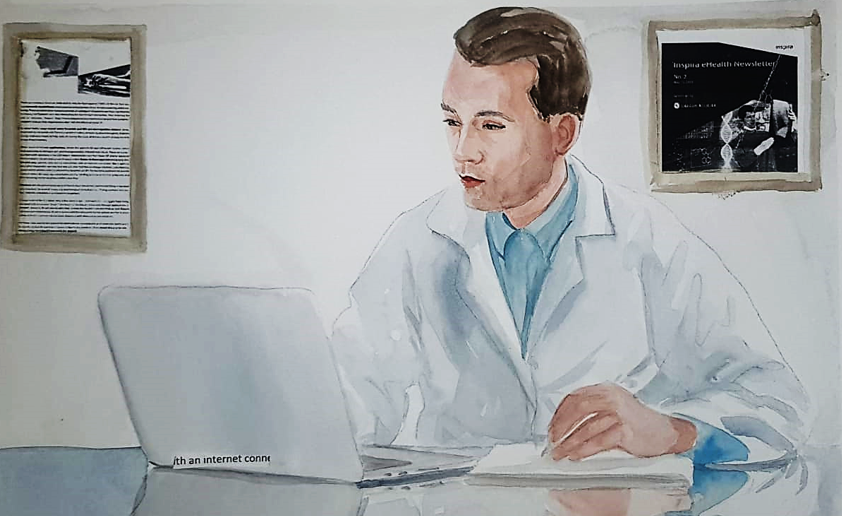
TRANSDIAGNOSTIC PSYCHIATRY: THE NEW TREND
In this section
The present symposium at the 30th Annual Congress of the European Psychiatry Association (EPA) in 2022 discussed the most recent research in transdiagnostic psychiatry. Three experts from across the globe, Dr. Marco Solmi and Professors Ole A. Andreassen and Robert F. Krueger, outlined how transdiagnostic approaches are revolutionising their field of expertise within psychiatry. Existing categorical diagnoses in psychiatry often come under scrutiny for their validity in clinical practice.1 The transdiagnostic approach has been proposed as a promising new avenue as, by definition, it cuts across existing categorical diagnoses and may even dispose of them completely1. In this symposium, the validity and reliability of transdiagnostic conceptualisation are discussed with respect to diagnosis, aetiology, and prevention and treatment.
Transdiagnostic psychiatry: diagnosis, prevention, and treatment
The symposium began with a talk by Dr. Marco Solmi, MD, PhD, Associate Professor in the Psychiatry Department at the University of Ottawa. In his lecture, Dr. Solmi shared some overview of his work on the concept of transdiagnostic psychiatry1 and its implications for prevention2–4 and treatment5.
Dr. Solmi started by discussing the current literature on transdiagnostic psychiatry through the systematic review of 111 studies1. Through this review, Dr. Solmi and his team identified six main criteria1 that can serve as guideline for improving the quality and consistency of future research in the field. These so-called “TRANSD”iagnostic research recommendations are the following1: Transparent definition of the gold standard (ICD,DSM, other); Report the primary outcome of the study, the study design and the definition of the transdiagnostic construct; Appraise the conceptual framework of the transdiagnostic approach; Numerate the diagnostic categories, spectra and non-clinical samples in which the transdiagnostic construct is being tested and validated; Show the degree of improvement of the transdiagnostic approach; Demonstrate the generalisability of the transdiagnostic construct1. Dr. Solmi then illustrated the importance of the first criterion of “TRANSD” using a hypothesised study that aimed to investigate increased body weight as a transdiagnostic construct across a range of clinical populations including schizophrenia, bipolar disorder, depressive disorder, and anorexia nervosa. If the individual diagnoses are omitted, the pooled effect size would suggest that increased body weight is a valid transdiagnostic criterion for all the included diagnostic groups, even though by definition, anorexia nervosa is characterised by low body weight. Therefore, Dr. Solmi concluded, each transdiagnostic construct must be confirmed in each individual diagnostic group before it can be confirmed as being transdiagnostic.
Dr. Solmi then proceeded to discuss the role of transdiagnostic psychiatry in prevention. A systematic review of meta-reviews showed that there are many transdiagnostic risk factors for mental health disorders that can already be identified in childhood, the perinatal period or even during the pregnancy of the mother2. Nevertheless, there is not enough evidence favouring broader transdiagnostic preventative approaches compared to monodiagnostic prevention2. In line with this evidence, a systematic review of controlled trials for universal and selective prevention for mental health symptoms suggests that in the case of individuals with more severe, almost clinically relevant symptoms, selective prevention methods are superior to universal prevention3. Dr. Solmi concluded that most evidence among transdiagnostic interventions is for physical exercise, as indicated by a meta-review of the existing literature4.
Moving on to treatment, Dr. Solmi presented an umbrella review of the efficacy of aripiprazole monotherapy as transdiagnostic intervention for a range of mental disorders5. Applying the “TRANSD” criteria, the evidence indicates that aripiprazole improves primary symptoms of mental disorders across diagnoses and spectra, including dementia, schizophrenia, autism spectrum disorder, etc5. Additionally, research indicates that the most effective transdiagnostic intervention is physical activity and this has been endorsed by the EPA in 20186.
The talk was concluded by summarising the use of “TRANSD” in transdiagnostic research. Dr. Solmi reminded listeners that before dropping traditional diagnostic categories, the effectiveness of transdiagnostic approaches needs to be more thoroughly investigated. Finally, he acknowledged the existence of other transdiagnostic theoretical frameworks, such as the Hierarchical Taxonomy of Psychopathology (HITOP)7 and the P-factor model (P-Factor-COH-FIT)8.
Shared Genetic Aetiology of Psychiatric Diseases
The second talk of the symposium was held by Prof. Ole A. Andreassen from the Institute of Clinical Medicine, University of Oslo, on the shared aetiology of psychiatric diseases.
Prof. Andreassen began his talk by presenting new information about the genetic architecture of diseases revealed through the global Psychiatric Genomics Consortium (PGC)9. Firstly, the Professor shared results that suggest that many psychiatric diagnoses are highly polygenic, meaning that dozens or even hundreds of single nucleotide polymorphism (SNP) in the genome are significantly associated with each diagnosis10. Secondly, data has revealed that there is a large degree of genetic correlation between mental disorders, meaning that the risk for one disorder increases the risk for another11. Furthermore, new mathematical models have enabled researchers to precisely quantify this overlap12. For example, it is estimated that 5.6 thousand variants are associated Attention Deficit and Hyperactivity Disorder (ADHD) and 14.5 thousand variants are associated with major depression (MD)12. At the same time, there is an overlap of around 4.4 thousand variants between the two, which are shared genetic variants. Prof. Andreassen suggested that these overlapping variants can be investigated to explore the biology underlying comorbidity between psychiatric disorders.
Continuing with the insights from the analysis of the genetic overlap between disorders, Prof. Andreassen pointed out that there is a high genetic overlap between schizophrenia and bipolar disorder, schizophrenia and MD and MD and bipolar disorder but a lower overlap between ADHD and bipolar disorder than expected12. Additionally, the mathematical model can also be used to quantify the genetic overlap between personality traits and disorders13, e.g., a large overlap between MD and neuroticism has been found. It can also quantify the overlap between disorders and certain cognitive traits, such as education.
In the second half of the talk, the Professor admitted that it is not easy to understand the individual mechanisms of genes when it comes to polygenic disorders14. To overcome this limitation, the ENIGMA consortium of large-scale magnetic resonance imaging (MRI) was established to investigate the association between mental phenotypes and brain structure and function15. Using schizophrenia as an example, Prof. Andreassen showed evidence to suggest that although there is a genetic overlap between schizophrenia and cortical thickness and surface area16, individual SNPs seem to affect the whole brain (or large, distributed portions) with mixed effect directions17, i.e., not all brain regions are affected in the same way. According to the Professor, this finding can explain why the same brain biology can affect several types of mental traits to varying degrees, producing a spectrum of symptoms that lead to diagnostic categories within mental disorders in psychiatry.
As the talk came to a close, Prof. Andreassen recapitulated that there seems to be a complex pattern of genetic overlap across mental traits and disorders9, and patterns of polygenic overlap between SNPs and brain biology18. He concluded that to understand the complexity of psychiatric disorders, research must aim to link diagnosis with different phenotypes, brain function, and genetic factors.
The Alternative Model of Personality Disorders
In the final talk of the session, Prof. Robert Krueger, Distinguished McKnight University Professor in the Department of Psychology at the University of Minnesota, discussed how the Alternative Model of Personality Disorders (AMPD)19 is the vanguard of mental health practice and research today.
In the first half of the talk, Prof. Krueger introduced the AMPD, the now accepted model of personality disorder (PD) in the Diagnostic and Statistical Manual of Mental Disorders, Fifth Edition (DSM-5)19, which is highly similar to the one included in the eleventh edition of the International Classification of Diseases (ICD-11). There are two major parts to the model: Criterion A, which refers to functional impairment and Criterion B, which refers to pathological personality traits19. Whilst Criterion A identifies and describes the overall mechanism of PD, Prof. Krueger explained, Criterion B traits fill in the details, providing the precise “flavour” of the disorder. Criterion A can be divided into two elements19: Self and Interpersonal Functioning. Self is further subdivided into Identity, such as perceiving the self as unique, having clear boundaries between self and others, and Self-direction, such as the pursuit of meaningful goals and the ability to self-reflect19. Interpersonal functioning, on the other hand, can be divided into Intimacy, i.e., depth and duration of connectedness with others, and Empathy, i.e., comprehension and understanding of the motivations and experiences of others19. Prof. Krueger then offered some specific examples of clinical presentations of difficulties in self and interpersonal functioning.
Moving on to Criterion B20, Prof. Krueger defined five major domains: negative affect, detachment, antagonism, disinhibition and psychoticism. He then proceeded by describing the possible clinical presentation of each of these domains20: negative affect may manifest as anxiety or emotional lability; detachment as withdrawal, anhedonia, and intimacy avoidance; antagonism as manipulativeness and grandiosity; disinhibition as irresponsibility and impulsivity, and finally, psychoticism as unusual beliefs and experiences, and perceptual dysregulation. These five domains may be present to varying extent in individuals with PD depending on the specific cluster of symptoms they exhibit. Using the AMPD allows medical professionals to define different combinations of these elements with more flexibility and sensitivity compared to previous categorical diagnostic models19.
Towards the end of the talk, Prof. Krueger presented the Personality Inventory for DSM-5 (PID-5)20, a tool for assessing Criterion B. This form is available for free online and has several versions of varying lengths. It can be filled out by an informant of by the patient themselves, be used for younger people aged 11 to 17, and has been translated into numerous languages20.
To conclude, Prof. Krueger highlighted that the strength of AMPD is that instead of reducing the patient to a diagnostic category label, it allows for the conceptualisation of the person in a multifaceted way, enabling a more person-centred treatment and care20. For example, in the case of younger people, the AMPD allows the comparison of the patient’s displayed tendencies with the developmental norms, providing a developmental contextualisation that goes beyond characterising people according to category labels. Accordingly, there is evidence to suggest that the AMPD has improved clinical utility relative to more inflexible categorical approaches21,22.
References
- Fusar‐Poli, P. et al. Transdiagnostic psychiatry: a systematic review. World Psychiatry 18, 192–207 (2019).
- Arango, C. et al. Risk and protective factors for mental disorders beyond genetics: an evidence‐based atlas. World Psychiatry 20, 417–436 (2021).
- de Pablo, G. S. et al. Universal and selective interventions to prevent poor mental health outcomes in young people: systematic review and meta-analysis. Harv. Rev. Psychiatry 29, 196–215 (2021).
- Firth, J. et al. A meta‐review of “lifestyle psychiatry”: the role of exercise, smoking, diet and sleep in the prevention and treatment of mental disorders. World Psychiatry 19, 360–380 (2020).
- Solmi, M. et al. Aripiprazole monotherapy as transdiagnostic intervention for the treatment of mental disorders: An umbrella review according to TRANSD criteria. Eur. Neuropsychopharmacol. 41, 16–27 (2020).
- Stubbs, B. et al. EPA guidance on physical activity as a treatment for severe mental illness: a meta-review of the evidence and Position Statement from the European Psychiatric Association (EPA), supported by the International Organization of Physical Therapists in Mental Health (IOPTMH). Eur. Psychiatry 54, 124–144 (2018).
- Ruggero, C. J. et al. Integrating the Hierarchical Taxonomy of Psychopathology (HiTOP) into clinical practice. J. Consult. Clin. Psychol. 87, 1069–1084 (2019).
- Solmi, M. et al. The Collaborative Outcomes study on Health and Functioning during Infection Times in Adults (COH-FIT-Adults): Design and methods of an international online survey targeting physical and mental health effects of the COVID-19 pandemic. J. Affect. Disord. 299, 393–407 (2022).
- Sullivan, P. F. et al. Psychiatric genomics: an update and an agenda. Am. J. Psychiatry 175, 15–27 (2018).
- Power, R. A. et al. Polygenic risk scores for schizophrenia and bipolar disorder predict creativity. Nat. Neurosci. 18, 953–955 (2015).
- Brainstorm Consortium et al. Analysis of shared heritability in common disorders of the brain. Science 360, eaap8757 (2018).
- Frei, O. et al. Bivariate causal mixture model quantifies polygenic overlap between complex traits beyond genetic correlation. Nat Commun 10: 2417. (2019).
- Hindley et al. in submission.
- Gandal, M. J. & Geschwind, D. H. Polygenicity in psychiatry—like it or not, we have to understand it. Biol. Psychiatry 89, 2–4 (2021).
- Thompson, P. M. et al. The ENIGMA Consortium: large-scale collaborative analyses of neuroimaging and genetic data. Brain Imaging Behav. 8, 153–182 (2014).
- Cheng, W. et al. Genetic association between schizophrenia and cortical brain surface area and thickness. JAMA Psychiatry 78, 1020–1030 (2021).
- van der Meer, D. et al. Understanding the genetic determinants of the brain with MOSTest. Nat. Commun. 11, 1–9 (2020).
- Trubetskoy, V. et al. Mapping genomic loci implicates genes and synaptic biology in schizophrenia. Nature 604, 502–508 (2022).
- American Psychiatric Association. Diagnostic and statistical manual of mental disorders: DSM-5. (American Psychiatric Publishing, 2013).
- Krueger, R. F., Derringer, J., Markon, K. E., Watson, D. & Skodol, A. E. Initial construction of a maladaptive personality trait model and inventory for DSM-5. Psychol. Med. 42, 1879–1890 (2012).
- Bornstein, R. F. & Natoli, A. P. Clinical utility of categorical and dimensional perspectives on personality pathology: A meta-analytic review. Personal. Disord. Theory Res. Treat. 10, 479 (2019).
- Milinkovic, M. S. & Tiliopoulos, N. A systematic review of the clinical utility of the DSM–5 section III alternative model of personality disorder. Personal. Disord. Theory Res. Treat. 11, 377 (2020).



